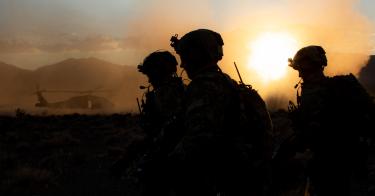Dakota Wood

China, Russia, Iran, and North Korea, among others, have invested heavily to modernize their forces and equip them with the most up-to-date technologies.
At present, the U.S. military remains marginally capable of defending the country and its interests.
America’s competitors are developing and deploying new technologies that will make their conventional forces far more effective in open combat. The question before Congress is: Will the U.S. try to keep up?
Unprecedented spending in response to the pandemic has driven the national debt to new heights. As Congress struggles to pass a now overdue federal budget, defense spending—both how much and how it should be spent—is under the microscope.
Those on the left bewail the “militarization of foreign policy” and insist the money would be better spent on beans rather than bullets. Others say the Pentagon should abandon plans for high-end ships and planes in favor of robots and cyber tools.
Advocates for more robust military spending argue that the world has grown increasingly dangerous, with major powers actively working to impose their will on other countries at the expense of U.S. interests. To deter or defeat such aggressive competitors, they insist, nothing beats physically owning key terrain.
They note that if the cyber and electronic systems of opposing sides essentially neutralize each other, it is the sustained use of physical equipment and forces that will carry the day in protecting essential national interests.
China, Russia, Iran, and North Korea, among others, have invested heavily to modernize their forces and equip them with the most up-to-date technologies. Russia’s military is the most modern it has fielded since the collapse of the Soviet Union. China’s navy is nearly 20% larger than the United States’ and is 15 years ahead of the U.S. in modernization and expansion.
North Korea recently revealed its largest and most capable intercontinental ballistic missile ever, adding it to its growing inventory of nuclear weapon delivery options. Meanwhile, Iran has redoubled its efforts to support terrorist groups, expanded its missile inventory to threaten all other countries in the Persian Gulf region, and employed nuclear blackmail to keep European countries compliant with Iran’s nuclear aspirations.
All of these countries have proven cyber capabilities and are now refining a wide array of unmanned systems and their tactical use.
Meanwhile, the U.S. is faced with the challenge of rebuilding its military after a decade of neglect following the end of the Cold War, two decades of sustained use since the terrorist attacks of Sept. 11, 2001, and 10 years of irresponsible underfunding stemming from the Budget Control Act of 2011.
In 2014, when The Heritage Foundation began tracking the status of the U.S. military with the “Index of U.S. Military Strength,” the services were consistently deferring maintenance, postponing modernization programs, and not even considering force expansion. Job No. 1 was as basic as it gets: to improve readiness to assure the success of ongoing operations.
The equipment and platforms the services possessed were very old, consuming unnecessarily high levels of funding for maintenance and repair. Readiness was at worrisome levels due to limited flight hours for pilots, inadequate funding for field exercises, and little time available for the troops to do anything other than prepare for the next deployment.
Over the next few years, conditions across the Joint Force did not change much, and in some cases worsened. It was not until Congress provided supplemental funding in 2017 that the Pentagon was able to start turning the tide in readiness.
From 2018 onward, gains were made in unit and personnel readiness, maintenance backlogs were reduced, and major acquisition programs were stabilized. Meanwhile, policy decisions to reduce operations in the Middle East and South Asia brought much needed relief to the force, allowing the Pentagon to assess and begin adjusting to the reorientation demanded by the new National Defense Strategy. That strategy adopted a marked shift from counter-terrorism and counter-insurgency operations to meeting the rapidly evolving challenges posed by major powers such as China and Russia.
The 2020 “Index of U.S. Military Strength” still finds the U.S. military to be too small for the tasks it is assigned, and its old equipment is not being replaced as quickly as it should be. But the services now have a better sense of what they need to do nearly 20 years after 9/11 and are now enabled by a stronger executive branch commitment to fixing problems in readiness and modernization that have been a quarter-century in the making.
Americans expect that the U.S. military will defeat any foreign physical threat to the country and its interests. As captured by the upcoming 2021 “Index of U.S. Military Strength,” to be released in mid-November, the services are getting there, but still have much work to do.
The pace of modernization must increase. The services must be able to buy new equipment faster than legacy items are retired. And readiness must increase for more of the force than just those units that are readying for deployment. Additionally, the service still must expand in size to reverse three decades of shrinkage.
At present, the U.S. military remains marginally capable of defending the country and its interests. It is big enough, modern enough, and ready enough to defeat one major opponent in one part of the world, but it’s not prepared to accomplish much more than that.
Congress and the next administration must ensure that, going forward, the defense budget for fiscal year 2021 serves as a floor rather than a ceiling for securing our country and its future.
The goal should be to increase funding by at least three percent above the rate of inflation, so that our military can regain the capability it needs to defend America in a new era of great power competition.
No comments:
Post a Comment